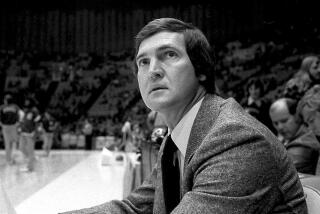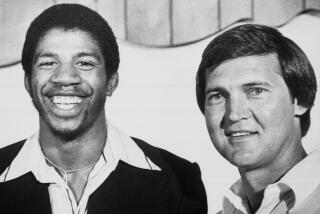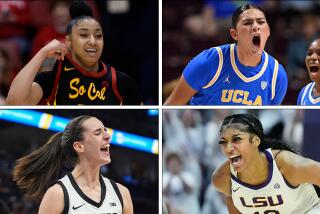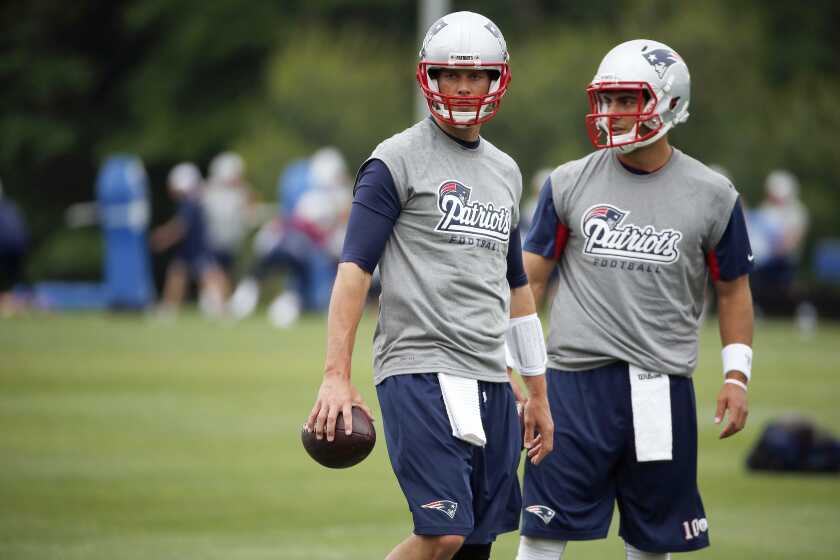It Took Some Time to Turn Into a Classic
The game itself was more mundane than magic. There was no miracle, no rally, no last-second winner. The little team that could -- with the championship on the line -- couldn’t. David not only got stomped by Goliath, he had to play hurt, with a thumb splint and a slingshot that flung mostly bricks, not a giant-killer in the bunch.
Twenty-five years later, David’s coach is still complaining about the officiating.
The final score was Michigan State 75, Indiana State 64.
Or, if you prefer the bottom line: Magic Johnson 1, Larry Bird 0.
That was when Johnson and Bird started keeping score. That was when the rivalry began, on March 26, 1979, in Salt Lake City, in the NCAA championship game, months before Johnson and Bird would begin the real miracle -- saving the NBA.
In the years ahead, Johnson would revolutionize the point guard position, Bird would restore the Boston Celtics’ faded glory and in their fabled clashes in and outside the NBA Finals, they would reenergize a league that ended the 1970s wounded by drug scandal and fan and media apathy.
Retroactively, Round 1 has been accorded legendary status, primarily because it is the first in a classic collection and was a big deal at the time -- with a 24.1 rating and a 38 share, it remains the highest rated basketball telecast in history.
But those who believe the 1979 NCAA final clearly foreshadowed what was in store for Johnson, Bird, the Lakers, the Celtics, the NBA and America need to re-acquaint themselves with the game footage, which ESPN Classic is airing several times this week -- today at 8 a.m. and 2 p.m. and three times Friday on a six-hour loop beginning at 10 a.m.
Bird made only a third of his shots, going seven for 21 from the field, bothered by a broken thumb and Michigan State’s smothering defensive double-teams.
During the telecast, NBC analyst Al McGuire described Johnson as only the second-best player on his team.
“I don’t want to hurt the Magic Man,” McGuire said midway through the second half, “but I think Greg Kelser is the most important man on the Spartans.”
This was the future of professional basketball?
“We’ve rewritten history on the event,” said Dick Enberg, who called the 1979 final for NBC. “It was important in ’79 because of the obvious David and Goliath script. But the game itself was really pretty ordinary. The Big Ten monster was obviously a better team.
“You left with the feeling Larry Bird could have gone to any one of 50 mid-major schools, or whatever we tagged them then, and they might have made it to the Final Four. It was Larry Bird and a couple good players [for Indiana State], but Michigan State had three great players -- they had three that went into the NBA.
“You know, Magic wasn’t the only star. Greg Kelser was as good as anybody. I remember Al McGuire saying that Kelser was the star of the game. And then you had Jay Vincent and he went on to the big time. It was just a matter of a group of great players ganging up on one great player. And no matter how fast that deer can run, the pack of cheetahs is going to get him.”
Still, many view the game as a turning point for college basketball and its annual tournament.
It was the last time an undefeated team played in the final. Indiana State took a 33-0 record into the game.
It was the last time a school from a smaller conference broke through to the championship game. Indiana State, from the Missouri Valley Conference, was mid-major before “mid-major” was part of the media parlance.
It was one of the last finals played in an on-campus arena -- an audience of 15,410 attended the game at the University of Utah’s Special Events Center -- before the encroaching madness of the 1980s and 1990s swept those games inside massive domed stadiums.
“That game, the 1979 NCAA championship, was a seminal moment in the history of college basketball,” said Crowley Sullivan, director of programming and acquisitions for ESPN Classic. “College basketball sort of caught lightning in a bottle, accidentally, when Magic and Bird collided that year. And to this day, it’s still the most watched college basketball championship of all time.
“Prior to that, the NCAA tournament was a big deal, but really that’s when Magic and Bird ushered in the modern era of March Madness. They really created March Madness. And without that game, I’m not sure that their rivalry throughout the ‘80s would have necessarily taken on the same mystique.
“That game was basically the appetizer to what they wound up doing throughout the 1980s, which was, in essence, saving the NBA.”
Bill Hodges, who coached the 1979 Indiana State team, believes that game “probably started the modern era of Final Fours. Up until that time, you could get a ticket up till game time. You’d go to the coaches dinner, where the Final Four coaches were, and there might be 50, 75, 100 guys. And you knew them all.
“Now it’s gotten so big -- the popularity of it, and the TV coverage. That year, we only played on national TV one time before the tournament started. Today, ESPN has everybody on.”
Which, in Hodges’ view, is “good and bad. I think sometimes it gets a little bit over-saturated. People don’t go to games like they used to, because they can sit at home and watch Duke play.
“[But] it sure has made the Final Four big.”
*
ESPN Classic recently brought Hodges and former Michigan State Coach Jud Heathcote together via remote to review and discuss the 1979 final for its “Big Ticket” series. Hodges said it was the first time in 25 years he has watched the game film in its entirety.
“I’d never watched the whole thing,” he said. “I watched bits and pieces.”
Why not?
“Never had a reason to.”
And what did the game’s losing coach think after finally viewing it again, start to finish, 25 years later?
“The officiating was horrible,” Hodges said, and he did not laugh.
The point came across in the commentary provided by Enberg, McGuire and Billy Packer. When Indiana State guard Carl Nicks was whistled for a questionable foul, his fourth, Enberg noted, “It has not been a well-officiated game.... It’s the pressure. We’ve seen some unusual calls for both sides.”
McGuire then quipped that “at least when they’re incompetent, they’re incompetent for both sides.”
To which Packer, almost chiding his partner, replied: “That’s a little strong, Al.”
Oh my, to borrow a catchphrase from Enberg. How times have changed.
And that wasn’t all. Compared to the sensory-overload television experience of 2004, the footage from the 1979 game looks almost naked. No score-and-clock graphic anywhere on the screen. No ticker crawl across the bottom. No pop-up ads or requests to email your pick for most valuable player. And no three-point lines or corporate logos anywhere on the floor.
Just a bleached-wood basketball court and 10 players dressed in powder blue or white on the screen.
“Isn’t that delightful?” Enberg said, looking back on it today. “Now you have to read television. That’s our joke, ‘Let’s turn on the game so we can read what’s happening.’
“The [1979] graphics seem ancient. I think that’s where it’s changed most of all. It’s what we superimpose on the screen over the game.... I guess I’m wrong, but I always felt that we violate our audience when we have announcers saying one thing, the picture is something totally different and the graphic is a third thing. I always thought the three should be all on the same subject, so we could help the audience appreciate the point, or the moment, more.
“But I guess, as Al McGuire said, I’m going the way of the dinosaur.”
In retrospect, Hodges might have preferred a couple of three-point arcs on the floor. The NCAA had not adopted the three-point rule in 1979, much to the chagrin of the Indiana State Sycamores, who were forced to attack from long range by Michigan State’s 2-3 zone.
“Jud made a comment that if they had a three-point shot then, [Michigan State] wouldn’t have won,” Hodges said. “Most of the shots we had to shoot were three-point shots today.... We didn’t get the ball inside a lot.”
Johnson outscored Bird in their first meeting, 24-19. Johnson, voted the Final Four most outstanding player, made eight of 15 field-goal attempts to go along with seven rebounds and five assists. Bird had 13 rebounds and two assists, but his shooting was sub-par -- testament to Michigan State’s hounding defense and the thumb Bird broke when shaking hands with an overzealous fan after the Sycamores’ Midwest Regional final victory over Arkansas.
On “Big Ticket,” Heathcote joked that “that guy in Arkansas was a Michigan State graduate.”
Heathcote also noted the impact of another outside influence -- the media -- on the game and its surrounding atmosphere.
As soon as the Final Four teams arrived in Salt Lake City, Heathcote said, “The media is immediately talking about Michigan State and Indiana State. They don’t want to talk about Indiana State and DePaul. They don’t want to talk about Michigan State and Penn. From the day we got there, it’s the Bird Man against the Magic Man. And they wrote all those things prior to the semifinal games.
“That’s what captivated the entire country, the matchup between those two superstars.”
Sullivan called the Johnson-Bird showdown “the epitome of a classic rivalry. You know, city versus country, black versus white. Here was Magic Johnson, this 6-9 point guard, he basically revolutionized the point guard position. And Larry Bird had a different style. Their styles were a little bit different, [but] both were and are still basketball purists. They have great respect for the integrity of the game.
“I think that back in ‘79, people were sort of keying into that. They recognized that, I think.”
Enberg remembered talking about the game at a Salt Lake City restaurant a few hours after the final.
“It wasn’t as if you said, ‘Wow, that’s the greatest game ever’ or ‘Man, they’ll remember that one,’ ” he said. “It was the team you expected to win. You kind of hoped Larry Bird would have a terrific game, and he showed that even double- and triple-teamed that he was a super player. But the team versus team just didn’t match up.”
Enberg considers the 1968 UCLA-Houston regular season game, which pit Lew Alcindor against Elvin Hayes in the Houston Astrodome, to be college basketball’s high point.
“That was the game that showed the world that, hey, college basketball is major league material,” he said. “And I think in regards to the popularity of the game, that was the launching pad that catapulted it. And ’79 got it into the stratosphere, because of the publicity.”
The true impact of the ’79 game, Enberg said, was what happened with Johnson and Bird after Salt Lake City.
“The real impact wasn’t on this being a great college game and what’s it done for college basketball,” he said. “It was these two guys graduating into the NBA at a time when the pros really needed that kind of human lift. There’s no question about that.
“And I think that’s where we historically, now 25 years later, get confused. It did so much for the NBA, we want to go back to the game and say that was the greatest game. And it wasn’t.”
The 1979 NCAA final, in Enberg’s view, was “just a continuation. I just think it was part of the wave that started in Houston, and the surf got a little higher.”
*
(BEGIN TEXT OF INFOBOX)
All-America Teams
1978-79 FIRST TEAM
Larry Bird Indiana State
Mike Gminski Duke
David Greenwood UCLA
Magic Johnson Michigan State
Sidney Moncrief Arkansas
*
1978-79 SECOND TEAM
Bill Cartwright San Francisco
Calvin Natt NE Louisiana
Kelly Tripucka Notre Dame
Mike O’Koren North Carolina
Jim Spanarkel Duke
Jim Paxson Dayton
Sly Williams Rhode Island
*
AP Poll
1979 Associated Press Poll entering the NCAA tournament:
1. Indiana State; 2.UCLA; 3. Michigan State; 4. Notre Dame; 5. Arkansas
6. DePaul; 7. Louisiana State; 8. Syracuse; 9. North Carolina; 10. Marquette.
11. Duke; 12. San Francisco; 13. Louisville; 14. Pennsylvania; 15. Purdue.
16. Oklahoma; 17. St. John’s (N.Y.); 18. Rutgers; 19. Toledo; 20. Iowa.
More to Read
Go beyond the scoreboard
Get the latest on L.A.'s teams in the daily Sports Report newsletter.
You may occasionally receive promotional content from the Los Angeles Times.










